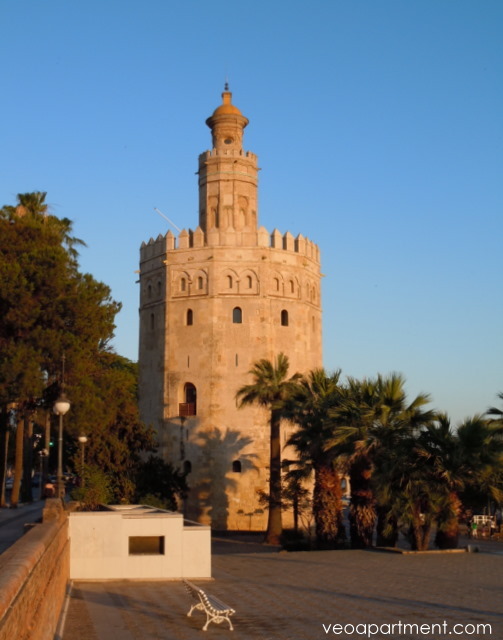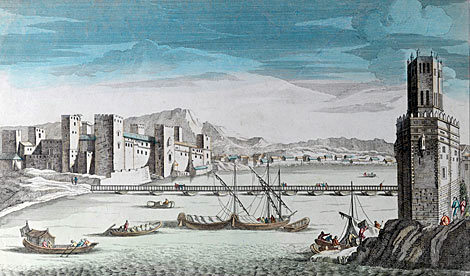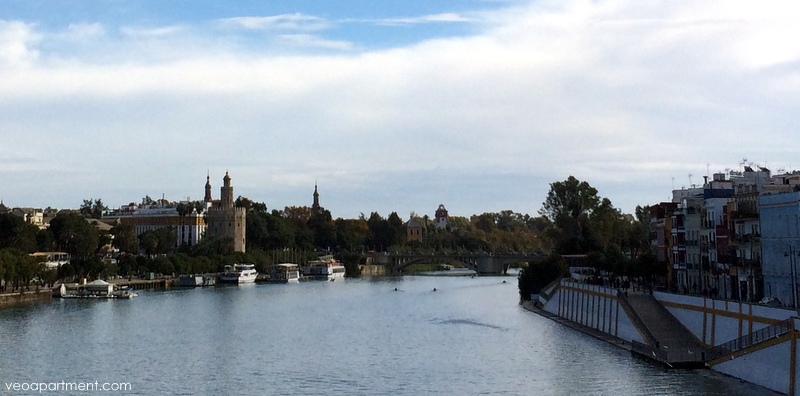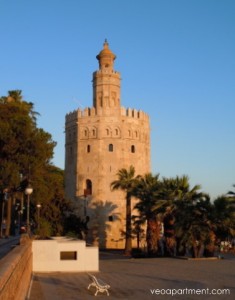This week we have another guest post from former Londoner, long-time Seville resident
and history buff Peter Tatford (aka Seville Concierge)
Although it’s not as grand as some of Seville’s other icons, such as the Cathedral, Alcázar or Plaza España, the Torre del Oro (Gold Tower) is still pretty impressive, and is in a very pretty location down by the river, making it one of Seville’s most popular spots.

The tower has a long and chequered history, and there are lots of stories surrounding it, some true, and some not, despite having wide currency. It was built in around 1220 by the Almohads, the Moslem rulers of the city, to protect the river and docks from the threat of the Christian armies of Ferdinand III, who finally conquered the city in 1248). It was once thought that it served to anchor one end of a heavy chain that could be used to block the river, the other being a tower in Fortaleza (Fortress) street in Triana. The only chain mentioned in the historical records, however, was alongside the Bridge of Boats (Puente de Barcas) where the Isabella II bridge now stands, and the name Fortress street is 19th century – perhaps deriving from the story.
 Bridge of Boats engraving courtesy of El Mundo
Bridge of Boats engraving courtesy of El Mundo
It took its name from its golden reflection on the water, a result of the materials from which it was constructed – a mixture of lime, mortar and pressed hay. You may hear that it was originally covered in gold tiles, but this comes from a much later account, and was certainly an invention. It is also sometimes said to have got its name from being used as a storehouse for gold coming from the Americas, but this is also not true, though it was used at various times as a chapel, a prison, and (with scant regard for historical heritage) a gunpowder store.
In 1755 the tower was damaged by the great Lisbon earthquake, and it was proposed to demolish it, but the people of Seville appealed to the king to save it. On the king’s orders the tower was repaired; at this time the stairway from ground level to the main door was removed (the current roadway did not exist at this time, and the ground on this side was at the same level as the river) and the third level round tower at the top was added. Access to the tower was by a walkway that extended from the city wall near the Torre del Plata. The remains of this walkway, and its alignment with the main entrance, can still be seen just inside the modern building opposite.
The tower survived another demolition proposal in 1868 (part of the general removal of the city walls that took place at this time), before becoming the Naval Museum in 1936, with further restoration work as recently as 2005 – 2008.
 Torre del Oro seen from the Isabel Bridge
Torre del Oro seen from the Isabel Bridge
(our Betis Blue apartments are on the far right)
It still houses the Naval Museum, which has some interesting maps and prints from the 16th century, model ships (including Columbus’s ship, the Santa Maria) and other artefacts and memorabilia. You can also climb to the top of the main section, which provides some great views along the river, and of the Cathedral. To the north the skyline is dominated by the new Torre Pelli, which sticks up like a sore thumb from the Cartuja.
The Arenal neighbourhood along the river between the tower and the Isabella II bridge is also home to the Bullring and shipyards, and lots of bars and restaurants, and being outside the heritage area offers good quality holiday rental accommodation at reasonable prices.
Naval Museum
Torre del Oro, Paseo de Cristóbal Colón, s/n
Tel: +34 954 222 419
Opening hours: Mon-Fri 9.30-18.45 Sat-Sun 10.30-18.45 Closed public holidays
Price: 3 euros students, pensioners and children 1.50 euros Mondays free
Website
